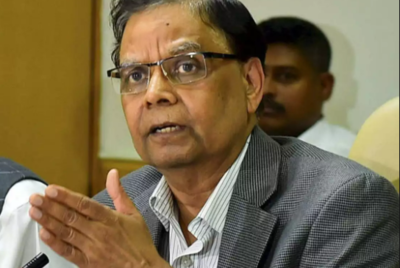
NEW DELHI: Former NITI Aayog Vice-Chairman Arvind Panagariya on Sunday stated it could be ‘foolish’ to match the financial scenario of Sri Lanka with India, although classes could be learnt from the disaster within the island nation.
Panagariya, in an interview with PTI additional stated for the reason that 1991 stability of funds disaster, successive governments have managed the macroeconomy conservatively.
He identified that within the case of India, fiscal deficits haven’t been allowed to get out of hand, the alternate price has been allowed to depreciate to maintain the current-account deficit low, financial coverage has been restrained to maintain inflation low and the opening of monetary capital flows has been executed in a calibrated trend.
“It is a foolish comparability…ideas of any parallels between India and Sri Lanka at present are laughable,” Panagariya stated, including that India has not often borrowed overseas to finance its fiscal deficit.
The eminent economist was requested to touch upon former Congress president Rahul Gandhi’s assertion during which Gandhi hit out on the Modi authorities over rising inflation and unemployment and stated India seems to be a “lot like Sri Lanka” and the Centre shouldn’t distract individuals.
Sri Lanka is grappling with a extreme financial disaster and India has been on the forefront of extending financial help to Sri Lanka.
Panagariya stated, “We should certainly take classes from the Sri Lankan expertise for our future macroeconomic administration. That’s the important relevance of the occasions there for India.”
Replying to a query on unemployment, Panagariya, a professor of economics at Columbia College asserted that India’s drawback isn’t unemployment; as a substitute, it’s under-employment or low-productivity employment.
“We have to work on creating well-paid jobs for the lots,” he stated, including that the unemployment price even within the Covid 12 months of 2020-21 had been all the way down to 4.2 per cent in contrast with 6.1 per cent in 2017-18.
The eminent economist famous that those that had raised a hue and cry on the 6.1 per cent price in 2017-18 have now gone utterly quiet on the unemployment charges reported by the Periodic Labour Power Survey (PLFS).
On questions raised by some specialists on India’s official knowledge on a variety of topics, he stated the nation’s GDP, PLFS and important statistics assortment fare effectively in worldwide comparisons.
“There are some real criticisms that must be addressed. We definitely want to take a position much more in revamping our knowledge assortment,” he famous.
Having stated this, Panagariya stated ‘we should additionally name out and reject many motivated criticisms’.
As an illustration, in accordance with him, these such because the Economist and New York Instances offering the choice estimates of Covid deaths in India want to use increased requirements to the analysis of their very own (extremely flawed) methodologies.
Requested whether or not he thinks the Indian economic system is in a greater place than it was eight years in the past, he stated, “You’ll be able to take a look at any indicator you want: per-capita earnings, poverty, life expectancy, diet, and toddler mortality. You will notice enchancment in every of those indicators.”
Responding to a query on the Indian rupee weakening to a report low, Panagariya stated the rise within the rates of interest in the US had led capital to maneuver out of rising markets and Europe into the US.
“That has led to a depreciation of practically all main currencies in opposition to the greenback. The rupee isn’t distinctive on this regard,” he stated, including that if something, the rupee has depreciated lower than most different currencies partially as a result of heavy intervention by the RBI.
Panagariya identified that whereas throughout 2022, the rupee has depreciated 7 per cent in opposition to the greenback, as compared, the Euro is down by 13 per cent, the British pound by 11 per cent and the Japanese yen by 16 per cent.
In Asia additionally, the South Korean received, Philippines peso, Thai baht and Taiwanese greenback have all fallen greater than the rupee in opposition to the US greenback.
“The online result’s an appreciation of the rupee in opposition to all of those currencies,” he argued.
On fears of financial recession, Panagariya noticed that persistent inflation at charges not witnessed in 4 many years and entrenchment of inflationary expectations, particularly in the US, have meant that the one means for the central banks to interrupt the again of inflation is thru the recession.
“That’s, the central banks should hold elevating the rates of interest till financial exercise sees a decline and forces a break in excessive inflation-high wage-high inflation cycle.
“In India, we don’t face the identical drawback,” he opined.
Replying to a query on excessive inflation, the eminent economist stated the supply of India’s inflation drawback is basically external– unprecedented sudden rise in oil and cereal costs triggered by the Russia-Ukraine battle.
With RBI elevating rates of interest, oil costs seeing some thaw and the most recent fruits and vegetable crops across the nook, he stated, “We’ll see inflation return to beneath 6 per cent by the second half of FY23, as identified by the RBI Governor.”
Pangariya famous that India’s inflation at 7 per cent exceeds its tolerance restrict of 6 per cent underneath inflation concentrating on by just one share level.
FbTwitterInstagramKOO APPYOUTUBE